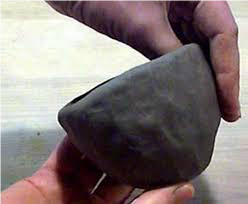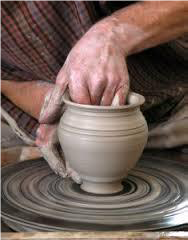Back to: BASIC TECHNOLOGY JSS3
Welcome to class!
In today’s class, we will be talking about the processing of ceramics, glass, plastics and rubber. Enjoy the class!
Processing of Materials – Ceramics, Glass, Plastics and Rubber

Ceramics, glass, plastics and rubber are non-metallic materials used to mould different shapes and items needed for domestic and commercial applications.
The moulds are produced through different processes and methods. It is important to know that all objects made from clay, mud (wet clay), cement and glass are called ceramics products.
Ceramics:
Ceramics are made of different products like clay, cement and concrete.
Pottery making:
The art of making objects from clay is called pottery. Examples are pots, tiles, sanitary wares, cups, plates and bricks.
Methods of processing ceramic materials
1. Excavation of clay:
Clay is usually excavated from the earth with a shovel. The clay is then processed so as to remove air bubbles and sand particles so that it can be moldable.
2. Moulding of clay:
This is the processing of clay to a particular shape. There are two basic methods involved. They are:
- The pinch method: This is the method of using the thumb, with the clay placed in the hollow of the palms while the thumb presses the clay into shape. The hollow is gradually expanded, and the sides are made thinner by using fingers to press inside the hole. This process is continued until the desired shape is formed.

- The potter’s wheel method: This is a device containing a flat disc which is spurned using either an electric motor or manual means. As the clay spins on the disc the article is shaped using the fingers. The potter’s wheel is a better and faster method than the pinch pot method.

3. Firing:
The firing of clay helps it to become hardened and durable. The kiln is usually used for this purpose.
4. Decoration:
This is the art of using varnished or ceramic paint to draw patterns on the surface of any clay product to beautify it.
Processing of glass
The raw materials used in making glass are sand, soda, lime, potash and lead oxide. These materials are thoroughly mixed together. The mixture is mixed and melted in a furnace at a very high temperature to produce molten glass. This result is then shaped and allows for cooling to form rigid shaped glass articles. The formed shaped is reheated and allowed to cool gradually. This process of reheating is called annealing.
NOTE: Annealing prevents damages in the cause of expansion and contraction in glass production.
Uses of glass
- Glass is used for making bottles, bulbs, flower vases, tumblers, doors and windows.
- Glass is used for making mirrors, windscreens of vehicles, television screens and computer screens.
Processing of plastics
Plastics are obtained from petroleum products called monomers. These monomers are used to produce resins which are used to for making plastics.
Types of plastics
1. Thermoplastics:
These are plastics that can melt under heat and then reshaped into other forms.
2. Thermoset:
These are plastics that do not easily melt under heat. They are used as handles for pots and enamel dishes.
Methods of processing of plastics
1. Injection method:
In this method, the resin is fed into a heating chamber through the hopper. A plunger is then used to force the molten plastic into the required mould. This method can be used for making water bottles.
2. Extrusion moulding:
This is the older version of the injection moulding. Instead of the plunger, a knob with a screw is used to force the molten plastic into the mould.
3. Compression moulding:
This is the method used for processing hollow pipes like biro cases, water pipes and drainage pipes. This method makes use of two moulds at a time.
4. Vacuum forming:
This is the method used in the processing of plastic cups, buckets and bowls. A vacuum is always created with the cavity of the mould. As air is sucked out of the cavity, the pressure is created on the plastic so as to take the shape of the mould.
5. Calendaring:
This is the method used to produce long sheets of plastics like nylon and polythene products. The plastic runs through several rollers.
Processing of rubber
There are two types of rubber:
- Natural rubber
- Synthetic rubber
Natural rubber:
It is produced from a variety of trees. Rubber is an elastic material obtained from the latex of rubber trees.
Latex is a liquid substance which looks like milk. As the latex is heated, it changes into an elastic soft and sticky solid which is called rubber. The raw rubber produced can further be improved through a process called vulcanization.
NOTE: Vulcanization is a special chemical treatment where sulphur is added to raw rubber and heated at a high temperature.
Vulcanization makes rubber harder, more elastic, durable and able to withstand high temperature.
Synthetic rubber:
It is artificially made rubber. It is also known as chemical rubber because it is derived from petroleum, coal, oil, natural gas and acetylene which are all chemical substances.
In our next class, we will be talking about DRAWING PRACTICES – PICTORIAL DRAWINGS: ISOMETRIC DRAWINGS. We hope you enjoyed the class.
Should you have any further question, feel free to ask in the comment section below and trust us to respond as soon as possible.

Very insightful…thanks👍
please a note on the processing of clay
what is compression or re explain processing of plastics